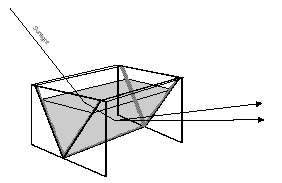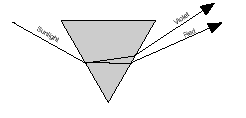Glass panes (five) 15x25 cm in size
Silicone cement (clear)
Emery paper (fine)
Cellophane tape
Water
Procedure:
1. Obtain the glass panes at a hardware or window store. Have them cut to size.
2. Use the emery paper to smooth out the glass edges to avoid cutting fingers during handling. (This can be done at the hardware store.)
3. Temporarily assemble the glass panes as shown in the diagram with cellophane tape. Glue the glass panes together by smearing each inside joint with silicone cement. This is how aquariums are made.
4. After the cement dries, remove the tape and fill the water prism with water. Check for leaks. If leaks are present, empty the water and dry the inside. Cement the leaks and allow the cement to dry.
5. Set the water prism in a window with a sunlit exposure. Cover the prism with the fifth pane to help keep the water clean. Sunlight will enter the prism and be dispersed into its rainbow colors. Ob-serve the colors that appear on the floor or wall.

Discussion:
The water in the water prism bends sunlight the same way glass does in a glass prism. Sunlight, entering the prism, is bent (refracted). Visible light rays (like sunlight) bend according to their wavelengths. Shorter wavelengths are bent more than longer wavelengths. This variable bending of the light causes its dispersion into the colors of red, orange, yellow, green, blue, and violet.
The water prism is a good starting point for capturing student interest in the electromag-netic spectrum. Not only will it disperse a broad swath of color across a classroom when sunlight enters it at the proper angle, it is also interesting to look through. The water prism disperses narrow bands of color along the edges of dark objects.

